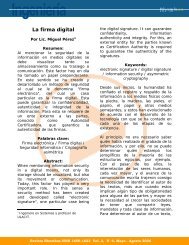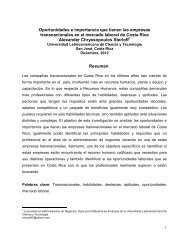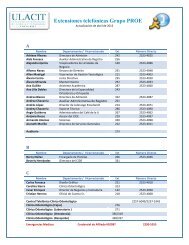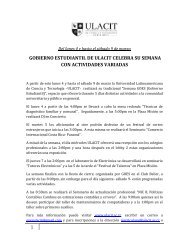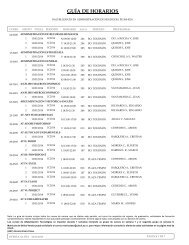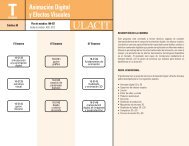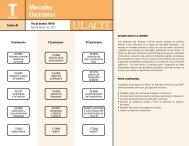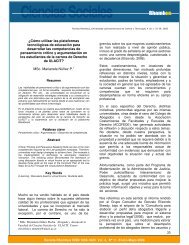IV Edición Revista Derecho en Sociedad - Ulacit
IV Edición Revista Derecho en Sociedad - Ulacit
IV Edición Revista Derecho en Sociedad - Ulacit
You also want an ePaper? Increase the reach of your titles
YUMPU automatically turns print PDFs into web optimized ePapers that Google loves.
DERECHO EN SOCIEDAD, N. º 4 . Enero del 2013<br />
<strong>Revista</strong> electrónica de la Facultad de <strong>Derecho</strong>, ULACIT – Costa Rica<br />
The flexibility in arbitration procedures comes as a result of one of it is cornerstones: party <br />
autonomy 6 .This principle <strong>en</strong>titles parties to a dispute to be the architects of the <br />
proceedings. This means, that parties are allowed to agree in a vast number of topics, <br />
including: (i) the number of arbitrators that will be responsible for reaching a decision; (ii) <br />
their time limit for reaching that decision; (iii) the selection of a method for choosing the <br />
arbitrators; (iv) the manner in which proceedings should be conducted; (v) The applicable <br />
law for to the dispute; (vi) to decide if the arbitration proceedings will be administered by <br />
an institution, or by the arbitrators themselves; (vii) determine which methods will be <br />
available to prove the facts of a dispute; and in g<strong>en</strong>eral, (viii) any other factor that falls in <br />
the sphere of the parties autonomy. <br />
The mandate, or objective that the members of an Arbitral Tribunal (sole or multi-arbitrator)<br />
is to reach a final and binding decision, an <strong>en</strong>forceable award. It is important to <br />
bring into account that the award ruled by the arbitrators, if dictated in one of the <br />
countries that has signed the New York Conv<strong>en</strong>tion, the decision will be <strong>en</strong>forceable in <br />
more than one hundred and forty jurisdictions. <br />
The consequ<strong>en</strong>ces of having an award can be glorious or disastrous, due to the differ<strong>en</strong>t <br />
places that the docum<strong>en</strong>t can be <strong>en</strong>forced; h<strong>en</strong>ce, it is of great importance to study the way <br />
that this arbitral tribunals are constituted, specially those tribunals that are formed with <br />
more than one arbitrator. <br />
The common practice in the multi arbitrator tribunals is that two out of the three <br />
arbitrators are unilaterally appointed by the parties, one each; and the third -‐the presiding-‐ <br />
arbitrator, is selected by the arbitrators appointed by the parties. This brings up all type of <br />
situations, from collaborative arbitrators that fulfills their functions with due dilig<strong>en</strong>ce; to <br />
interest is the Inter-‐American Conv<strong>en</strong>tion on International Commercial Arbitration (1975), Hereinafter <br />
‘Panama’ Conv<strong>en</strong>tion. <br />
6 Heuman, L. (2003) ‘Arbitration Law of Swed<strong>en</strong>: Practice and Procedure’. United States: Juris Publishing. <br />
Pag.249. <br />
72



